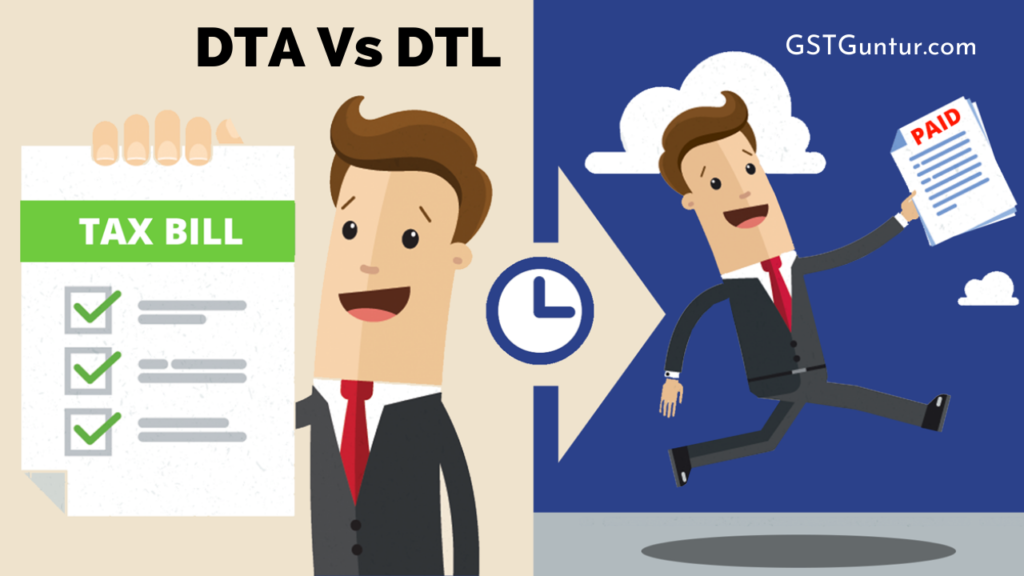DTA Vs DTL: What is the Deferred Tax? The word “deferred” means “delayed” or “postponed,” so deferred tax is a tax that has been projected for the present time that is due for that term but has not yet been paid.
The lag or postponement happens when there is a time delay between when the tax is accumulated and paid.
In a company’s financial records, there are both deferred tax assets and deferred tax liabilities. Because of the time differences between the two, there is a variation in the company’s accounting.
The two most basic forms of deferred tax are Deferred Tax Asset and Deferred Tax Liability.
What is the Deferred Tax Asset (DTA)
Deferred tax asset shows a firm’s situation of paid additional taxes or taxes in advance, which the organization then claims as a tax relief amount.
One may compare a deferred tax asset to rent charged in advance or refundable insurance premiums. Around the same time, the company no longer has capital on hand, but it does have equal value, expressed in the financial statements.
This asset contributes to the company’s potential tax burden being reduced. A deferred tax benefit is only known because the asset’s loss-value or depreciation gap is assumed to cover potential gains.
Deferred Tax Liability (DTL)
A deferred tax liability (DTL) is an income tax commitment resulting from a temporary disparity in book costs and tax deductions reported on the balance sheet that one will charge in a hypothetical accounting period.
The duty arises when a corporation or employee postpones an incident that would otherwise result in tax costs being recognized in the current year.
The disparity in time between when the tax is accrued and when it is paid causes the deferral.
The corporation receives its book profits from financial accounts compiled in accordance with the Companies Act’s laws, and the net benefit is calculated using the provisions of the Income Tax Act. Since such things are expressly permitted or disallowed for tax purposes each year, there is a distinction between book profit and taxable profit.
Difference Between Book and Taxable Revenue
The timing discrepancy is the difference between the book and taxable revenue or cost, and it may be any of the following:
- Temporary Difference – The company can resolve differences between book income and taxable income in the following year.
- Permanent Difference – The company cannot change the difference between book and tax revenue in the following cycle.
It is worth noting that DTA and DTL are only taken into account where a temporary difference exists.
In the guise of dta vs dtl, deferred tax assets are classified as non-current assets, while deferred tax liabilities are classified as non-current liabilities.
Both DTA and DTL will be adjusted for each other because they are constitutionally enforceable, and there is no intention to resolve liabilities and properties on a net basis.
Example
Let us consider that company A has the following details:
Income as Shown in a Company’s Books of Accounts
| Revenue | INR 600 |
| Expenses as per books | INR 100 |
| Taxable income | INR 500 |
Tax rate= 30%
Hence, tax= INR 150
Income as determined by the Tax Authorities
| Revenue | INR 620 |
| Expenses allowable as per IT authorities | INR 150 |
| Taxable income | INR 470 |
Tax rate= 30%
Hence, tax= INR 141
Today’s excess tax is attributable to the discrepancy between the taxes computed on the company’s books, and the income tax authorities’ income is 150-141=9.
This number, 9, is referred to as a deferred tax asset (DTA). During one or two future years, one will adjust it in the books of accounts.

References to Common Conditions in Which DTA, DTL Arises
- The disparity between how tax laws and accounting principles handle depreciation costs is a common cause of deferred tax liability. Depreciation cost on long-lived properties is customarily measured using a straight-line formula for financial reporting purposes, but tax laws enable businesses to employ an accelerated depreciation method. A company’s financial revenue is temporarily higher than the net income because the straight-line approach yields lower depreciation than the under-accelerated method.
- An instalment selling is another common source of deferred tax liability. When a corporation buys its goods on credit, the revenue is accepted and paid off in equivalent installments in the future. The corporation can realize net profits from the installment selling of general goods under accounting principles, but tax laws mandate the income to be recognized when installment purchases are made. This results in a temporary positive discrepancy between financial earnings and taxable revenue, as well as a deferred tax liability.
- If there is a discrepancy in accounting and tax laws, deferred tax assets may occur. Deferred taxes arise, for example, when payments are recognized in the income statement before the tax authorities expect them to be identified or when money is taxed before it is payable in the income statement.
- Essentially, it is an incentive to build a deferred tax benefit if the tax base or tax laws regarding assets and/or liabilities vary.
- Companies will frequently carry on their earnings from one year to the next, potentially lowering their tax liability. The deferred tax burden is established in this situation when the corporation will be obligated to pay taxes on the carry-forward earnings in the next year.
Presentation in the Balance Sheet And Other Noteworthy Features
- There are a few main features to remember when looking at deferred tax properties. For starters, they can be carried forward forever for most businesses beginning with the tax year, but they can no longer be carried out.
- The valuation of deferred tax assets is affected by tax rates, which is the second factor to remember. When the tax rate rises, it benefits the corporation because its valuation increases and offers a larger cushion for more significant revenue. However, as the tax rate decreases, the valuation of the tax asset decreases as well. This means that the organization will not take advantage of the total profit until it expires.
- The remainder of the deferred tax benefit and liabilities should be netted out, resulting in either DTA or DTL being disclosed in the balance sheet. Both cannot be announced at the same time for the same amount of time.
- DTL can be reported separately from current liabilities in the balance sheet under Non-current liabilities after the subhead ‘Long term borrowing’.
- Similarly, DTA can be reported separately from current assets in the balance sheet under Non-current assets after the subhead ‘Non-current investment’.
- The cumulative tax rate is used to establish the Deferred Tax. DTL’s book entries are as follows:
Profit & Loss A/c Dr.
To Deferred Tax Liability A/c
- There is a legitimate right to do so by the same tax body will existing tax assets and liabilities be reversed.
DTA and DTL Calculations
The disparity between net income and accounting profits before taxes is multiplied by the company’s expected tax rate to get the DTL.
Assume the business A uses INR 2000 in straight-line depreciation and INR 2500 in MACRS depreciation. The amortization for revenue and accounting purposes remains the same for the remaining years. The INR 500 difference is now just temporary.
If the tax rate is 30%, the corporation will report INR 150 as DTL in its accounts, i.e. 500*30%.
Also, the formula is:
Deferred Tax Liability Formula = Income Tax Expense – Taxes Payable + Deferred Tax Assets
Year 1: DTL = INR 50– INR 20+ 0 = INR 30
Year 2: DTL = INR 50 – INR 20 + 0 = INR 30
Year 3: DTL = INR 50 – INR 110 + 0 = -INR60
Cumulative Deferred Tax Liability on the Balance Sheet is as follows
Year 1 cumulative DTL = INR 30
Year 2 cumulative DTL = INR 30 + INR 30 = INR 60
Year 3 cumulative DTL =INR 60- INR 60= INR 0 (note the effect reverses in year 3)
DTL is supposed to reverse, i.e., they are the product of temporary disparities that will result in future cash balances after the taxes are collected. When an accelerated depreciation approach is used on the tax return, but straight-line depreciation is used on the income statement, it is more often produced.
To put it more simply, when you bill total depreciation on all books of account as per the IT Act and the Corporations Act at the end of the year, you’ll see that the deferred tax asset and liabilities have been cleared out, and the balance for a single asset is NIL.
